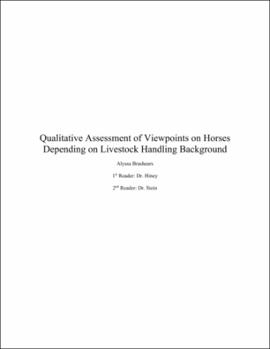| dc.description.abstract | The purpose of this study was to evaluate how individuals with varying livestock handling experiences interpreted equine affective states when presented with various equine images. A free choice profiling survey was distributed to undergraduate students at Oklahoma State University with varying demographics. Students were presented twenty pictures of horses illustrating different behaviors and asked to determine the horses affective state using free choice profiling. Free choice profiling gives the participants the freedom to choose their own descriptive words while describing the whole horse on its affective state. There were 175 responses (n=175) to the survey. Participants were grouped based on their self-assessed livestock handling experience on a scale of 0-100, with 0 meaning no experience and 100 meaning extreme experience. The group from 0-25 was the inexperienced group (IEX), which made up 27% (n=41) of the responses. The group from 26-50 was the moderately inexperienced group (MIEX), which made up 18% (n=28) of the responses. The group from 51-75 was the limited experience group (LEX), which made up 17% (n=26) of the responses. The group from 76-100 was the experienced group (EX), which made up 38% (n=57) of the responses. The responses from each of these groups were compared. Exclusionary criteria was used to limit word choice to only descriptions of affective states. A blinded group with the same demographics (n=5) was provided the selected words that fit the exclusionary criteria and asked to categorize them based on their valence and arousal level. The valence, interpretation of emotional measurements, was either positive (+1), negative (-1), or neutral (0). The arousal, the physiological state of being stimulated, was either high (+1), low (-1), or neutral (0). The mean of each valence and arousal level was used to assign a numerical assessment of the valence and arousal for the selected word. The level of agreement in the quantified groups, consensus, was determined if there was 70% agreeing with both valence and arousal state. Complete consensus in every group was reached for 4 images. In the IEX group, 8 reached consensus, while 3 differed in arousal level, 5 differed in valence level, and 4 differed in both areas. In the MIEX group, 8 reached consensus, while 1 differed in arousal level, 3 differed in valence level, and 8 differed in both areas. In the LEX group, 10 reached consensus, while 1 differed in arousal level, 4 differed in valence level, and 5 differed in both areas. In the EX group, 11 reached consensus, while 2 differed in arousal level, 4 differed in valence level, and 3 differed in both areas. Discriminate analysis and a MANOVA test were performed to determine whether there were significant differences among the groups and if there were differences between independent groups on more than one dependent variable. Out of 20 images, only 1 was significantly different (p<0.05), image 19. The rest were not significantly different (p>0.05). Based on the results, previous livestock handling experience does not influence undergraduate's assessment of affective states of equine. | |
